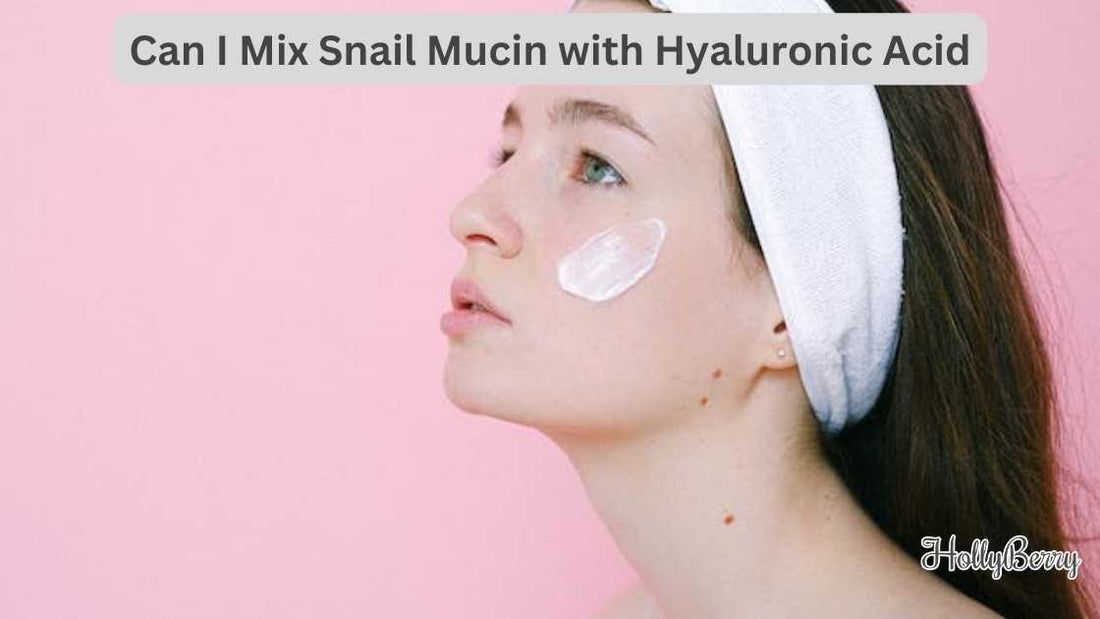
Can I Mix Snail Mucin with Hyaluronic Acid
Share
Unveiling Skincare Synergy

Snail mucin and hyaluronic acid are two active ingredients that have garnered attention in the skincare world for their hydrating and skin-repairing benefits.
Snail mucin, or snail secretion filtrate, is a complex mix of proteins, glycolic acids, and elastin, commonly used in Korean skincare regimens. It's touted for its ability to moisturise the skin, encourage collagen production, and help repair damaged skin tissue.
Hyaluronic acid, on the other hand, is a naturally occurring substance in the human body, known for its incredible ability to retain moisture.
In skincare, it's used to hydrate the skin, as it can hold up to 1,000 times its weight in water. When used topically, it helps in creating a protective barrier on the skin, giving it a plump and hydrated appearance.
Combining these two ingredients into a skincare routine can offer enhanced moisturising benefits.
The unique properties of snail mucin complement the moisture-retaining effects of hyaluronic acid, making them a potentially powerful duo for maintaining a well-hydrated and smooth complexion.
As these ingredients work differently, they can be used in conjunction to target various skin concerns effectively.

ORDER OUR HYALURONIC ACID SERUM HERE
The Science Behind Snail Mucin and Hyaluronic Acid
Snail mucin and hyaluronic acid are both revered for their skin-enhancing properties, with the former known for its healing properties and the latter as a potent humectant.
Understanding Snail Mucin in Skincare
Snail mucin, also known as snail secretion filtrate, is a complex blend of proteins, glycoproteins, enzymes, antimicrobial peptides, and hyaluronic acid. Dermatologists acknowledge its skin repair and anti-aging qualities due to its potent nutrients and antioxidants.
It's believed to stimulate the production of elastin and collagen, which are vital for a firm, youthful complexion. Snail mucin is considered particularly beneficial for sensitive skin due to its soothing attributes.
Benefits of Hyaluronic Acid for the Skin
Hyaluronic acid is a naturally occurring substance in the body, known for its astounding ability to retain moisture.
In skincare, it comes in the form of sodium hyaluronate, which provides deep hydration and a plumping effect to the skin, contributing to a moisturised and smooth appearance.
The humectant properties of hyaluronic acid make it essential for maintaining skin hydration levels, and it's often included in serums and moisturisers for its ability to attract and hold water.
Combining Snail Mucin With Hyaluronic Acid
When snail mucin is combined with hyaluronic acid in a skincare routine, they work synergistically to enhance skin hydration and repair. This combination offers a double dose of moisture while exploiting the healing properties of snail mucin and the plumping effect of hyaluronic acid.
Together, they can help diminish the signs of ageing and maintain a supple, radiant complexion.
Users should layer them correctly, applying lighter serums first and following with thicker consistencies for optimal absorption.
Incorporating the Mixture into Your Skincare Regimen
When combining snail mucin with hyaluronic acid, it is essential to follow proper techniques for application and be aware of possible side effects. Careful incorporation of these skincare ingredients can enhance moisture levels and contribute to a more youthful appearance.
Proper Application Technique
To effectively integrate snail mucin and hyaluronic acid into your skincare routine, follow these steps:
- Cleanse your skin thoroughly to remove any impurities and prepare it for the application of skincare products.
- Apply a serum containing hyaluronic acid to damp skin, which enhances its hydrating properties.
- After the hyaluronic acid serum has been absorbed, follow up with a snail mucin-based product. This could be in the form of a serum, gel, or moisturiser, depending on your preference and the specific products you've chosen.
- Allow the snail mucin to penetrate well before applying any further products.
- Continue with your usual skincare regimen, incorporating products like retinol, vitamin C, or moisturiser. Always finish with sunscreen during the day to protect your skin.
It's important to note that when integrating new skincare ingredients, especially with k-beauty skincare elements known for their hydrating and potentially anti-inflammatory properties, they should be added gradually to ensure compatibility with your skin.
Possible Side Effects and How to Mitigate Them
When utilising a combination of snail mucin and hyaluronic acid, observe these precautionary measures:
- Conduct a patch test before fully incorporating any new product into your routine to minimise the risk of allergic reactions or irritation.
- Sensitive skin types should be particularly vigilant and introduce the mixture slowly, monitoring their skin's response.
- If irritation occurs, cease the use of both ingredients and consult a dermatologist. A usual sign of irritation might include redness or itching.
- Avoid mixing with skincare products that could potentially negate the benefits or increase sensitivity, such as high-concentration retinol or vitamin C, without professional advice.
Regular monitoring of your skin's reaction will help mitigate any adverse effects and allow you to enjoy the cumulative hydrating benefits of both snail mucin and hyaluronic acid.
